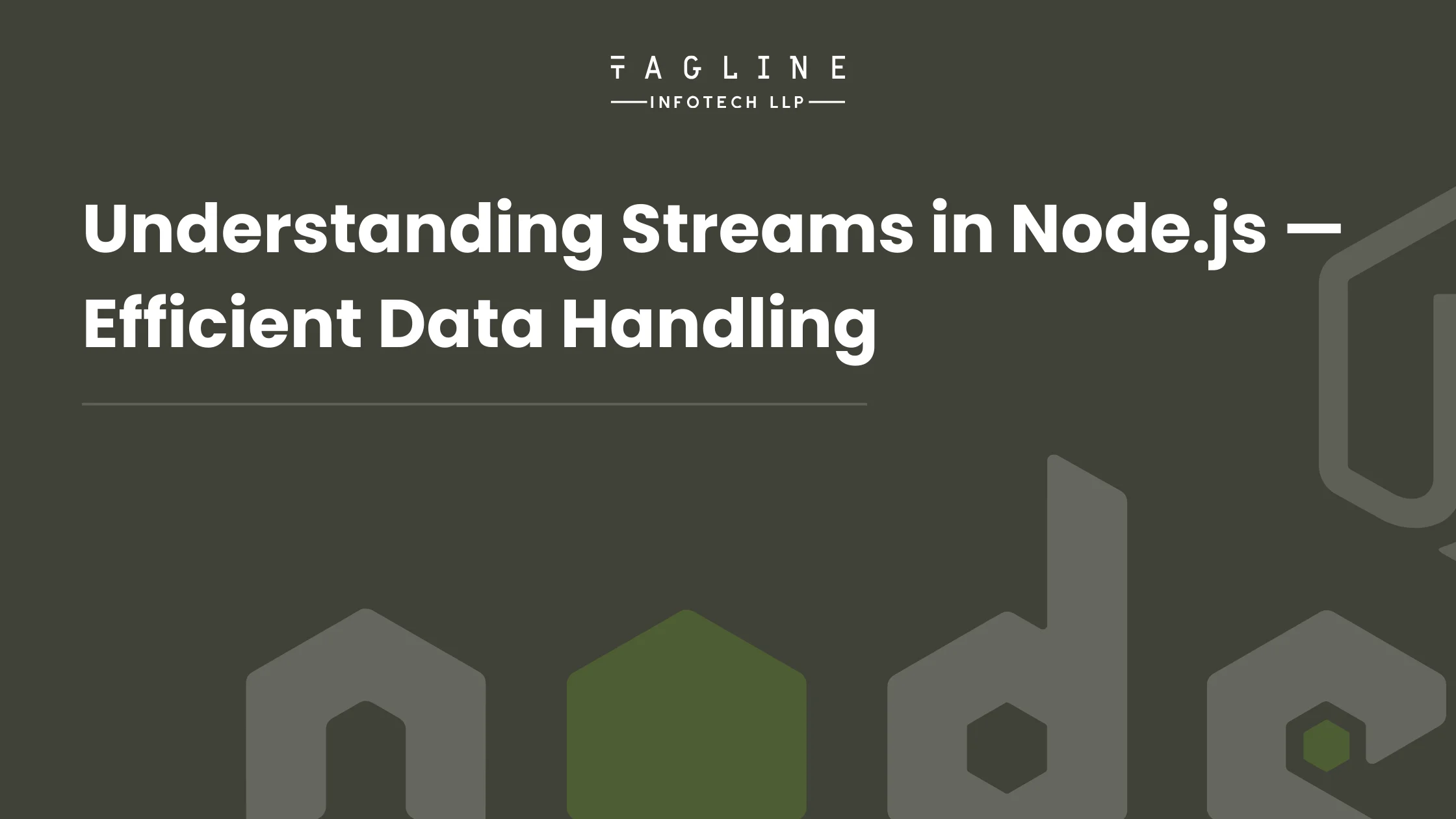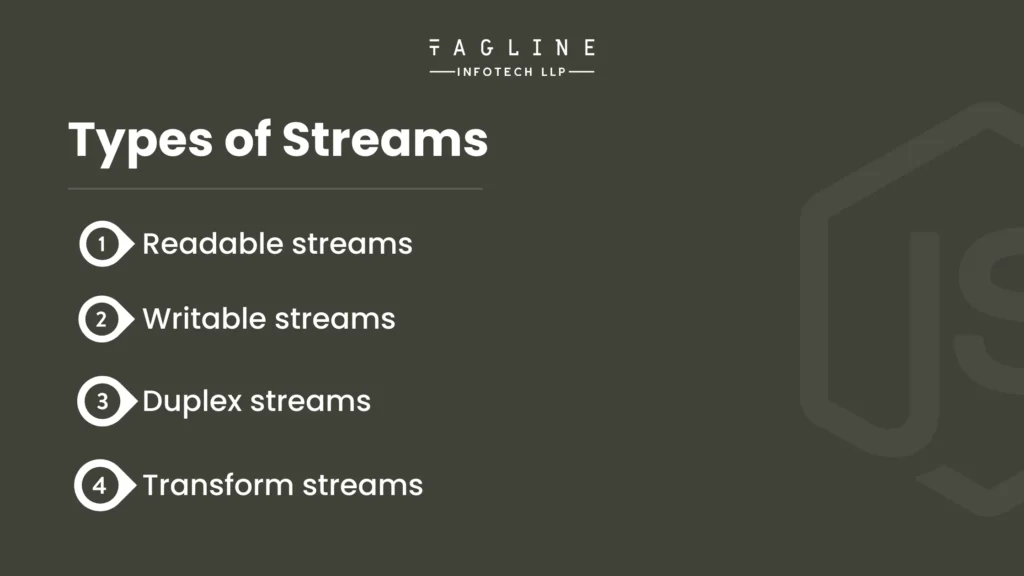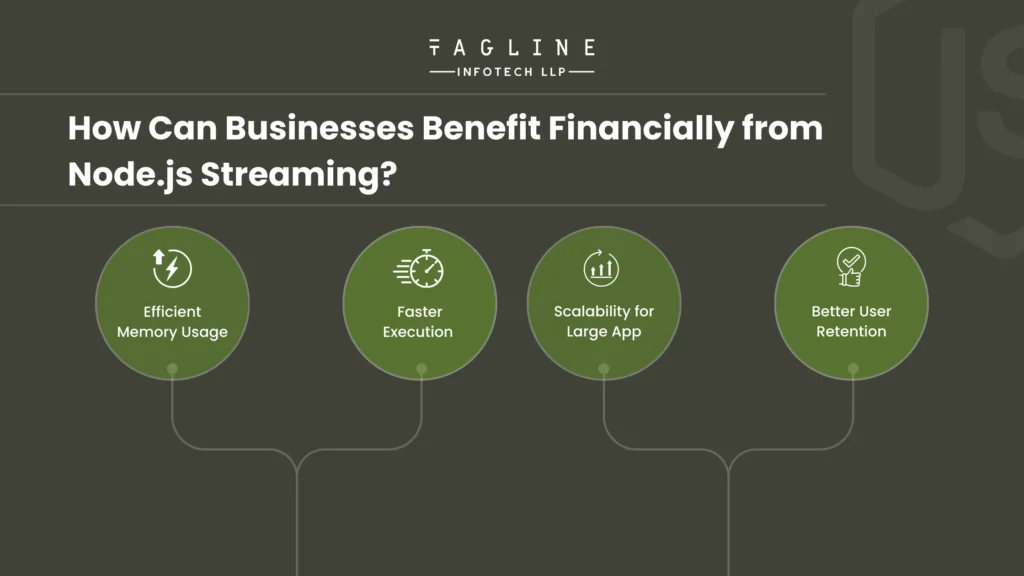Role of Python Libraries in Image Processing
October 30, 2025
Home >> Node.JS >> Understanding Streams in Node.js

Quick Summary
When building scalable applications, efficient data handling becomes crucial, especially as data sizes grow and computing resources remain finite.
Enter streams in Node.js, a powerful feature designed to handle data efficiently. But if you’re just starting out, streams can seem a little confusing.
Don’t worry—this guide is here to demystify the concept of streams and walk you through how to use them effectively in your Node.js applications.
Whether you’re running a startup or optimizing a business app, partnering with a Node.js Development Company can help you leverage streams to drastically improve your application’s performance and scalability.
Before we jump into the benefits, it’s essential to understand what streaming means in the context of Node.js.
A streams in node js is a sequence of data chunks that are processed efficiently in parts, rather than waiting for the entire data set to be available. Think of it like streaming a video on Netflix – you can start watching the video (data) while the rest of it is being downloaded in the background instead of waiting for the entire file to download first. Node.js employs streams to handle large-scale data flows without taxing system resources.
With this real-time data processing capability, Node.js streaming has made waves in industries like e-commerce, media streaming, and fintech, where high performance and low latency are critical. For developers seeking to master these capabilities, the Node.js streams documentation provides invaluable insights into efficiently handling data streams.

Node.js offers four main types of streams, and if you’re curious how many types of streams are there in Node.js, you’ll find the answer lies in these four categories, each serving a unique purpose.
Streams use the EventEmitter module in Node.js to handle asynchronous events. They emit different events as data is processed. Let’s break this down with an example.
Here’s a simple code snippet for reading data using streams:
const fs = require('fs');
// Create a readable stream
const readableStream = fs.createReadStream('large-file.txt');
// Listen to data events
readableStream.on('data', (chunk) => {
console.log('Received chunk:', chunk.toString());
});
// Listen to end event
readableStream.on('end', () => {
console.log('Stream finished.');
});
Notice how each data chunk is processed as soon as it’s available, without loading the entire file into memory.
Writable streams work by sending data to a destination in chunks. To write data using a writable stream, you use the `write` method.
Here’s how you could write data to a file using writable streams:
const fs = require('fs');
// Create a writable stream
const writableStream = fs.createWriteStream('output.txt');
// Write data to the stream
writableStream.write('This is the first line.\n');
writableStream.write('This is the second line.\n');
// Signal the end of writing
writableStream.end('Writing complete.\n');
// Listen to the finish event
writableStream.on('finish', () => {
console.log('All data has been written to the file.');
});
Writable streams follow a similar event-driven model as readable streams, making it easy to handle large data outputs.
Duplex streams allow for both reading and writing, while transform streams modify data on the fly.
A common example of a transform stream is file compression using the `zlib` module in Node.js.
Here’s how you can compress a file with transform streams:
const fs = require('fs');
const zlib = require('zlib');
// Create a readable stream
const readableStream = fs.createReadStream('input.txt');
// Create a writable stream
const writableStream = fs.createWriteStream('input.txt.gz');
// Create a transform stream for compression
const gzip = zlib.createGzip();
// Pipe the streams together
readableStream.pipe(gzip).pipe(writableStream);
writableStream.on('finish', () => {
console.log('File has been compressed!');
});
This example highlights the power of combining different stream types for efficient, real-time data processing.
Streams are powerful, but when working with them, you should keep the following in mind:
Node.js provides the `pipe()` method to simplify stream handling. It automatically manages streaming data, error propagation, and backpressure.
Backpressure occurs when a writable stream cannot process data as quickly as it’s being delivered by the readable stream. Use the `drain` event or `pipe()` to handle this.
In Node.js Always implement advanced error handling for robust applications:
readableStream.on('error', (err) => {
console.error('Stream error:', err);
});
Leverage packages like through2 or stream for additional utilities while working with streams.

The advantages of streams in node js aren’t just about performance—they also deliver cost savings. Here’s how:
Reading or writing large files at once can exhaust memory resources and crash your application. Streams mitigate this by working with smaller chunks, ensuring your app runs smoothly.
Streams start processing and delivering data immediately, rather than waiting for the entire data set to load. This results in faster execution and a better user experience.
Applications serving requests with heavy data traffic (like video streaming services) benefit immensely from streams, as they enable efficient, on-the-go processing.
Smooth, responsive applications lead to higher customer satisfaction and retention rates, boosting revenue over time.
Startups and small businesses, in particular, benefit from these cost efficiencies, allowing them to allocate resources to growth areas.
If your application deals with large data sets (e.g., log files, multimedia content, or real-time communications), streams are a necessary tool. They not only enhance performance but also improve scalability, making them an integral part of any efficient backend system.
Determine the most critical areas of your business that could benefit from real-time data processing. Whether it’s customer chat, file uploads, or large data transfers, start with your priority areas.
Node.js requires a distinct skill set, so it’s crucial to hire Node.js developers who can effectively leverage its streaming capabilities for maximum efficiency.
Node.js offers several pre-built libraries for streaming, such as `stream`, `readable-stream`, and `through2`. Incorporating these libraries into your application development can fast-track implementation.
If you’re new to Node.js, begin with a small implementation to familiarize yourself with the process. Scale gradually to include more operations as your team becomes more confident.
Streams represent one of Node.js’s most powerful features, offering a paradigm shift from traditional methods of handling data. By integrating streams into your application, you’re not just boosting efficiency—you’re future-proofing your system for optimized scalability and performance.
Are you ready to harness the power of streams in your next project? Start by revisiting one of your data-heavy tasks and refactoring it to use streams. You’ll be amazed at the difference!
For those asking, how many types of streams are there in Node.js, the answer is four. These streams include Readable, Writable, Duplex, and Transform, each serving distinct roles in handling data.
Use Node.js streams when handling large data efficiently, like reading files, processing streams, or managing real-time data transfer.
Yes, for application performance, Node.js is ideal as it allows fast data processing in streaming applications without blocking other operations, ensuring scalability.

Digital Valley, 423, Apple Square, beside Lajamni Chowk, Mota Varachha, Surat, Gujarat 394101
D-401, titanium city center, 100 feet anand nagar road, Ahmedabad-380015
+91 9913 808 2851133 Sampley Ln Leander, Texas, 78641
52 Godalming Avenue, wallington, London - SM6 8NW